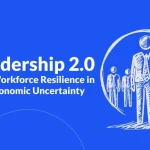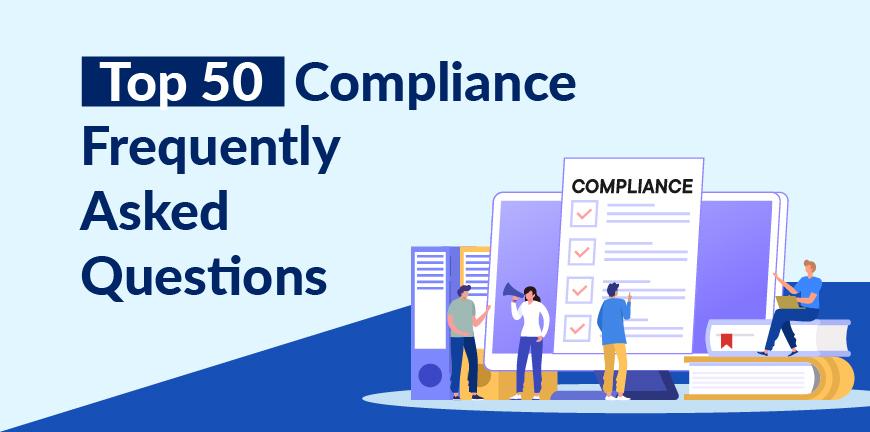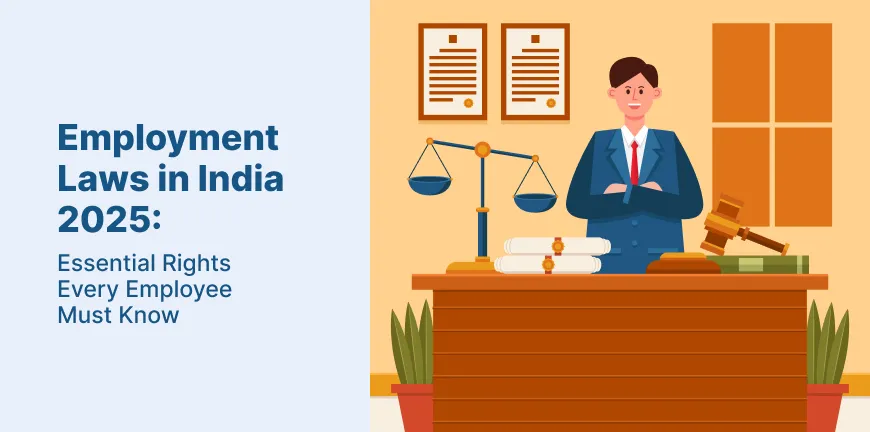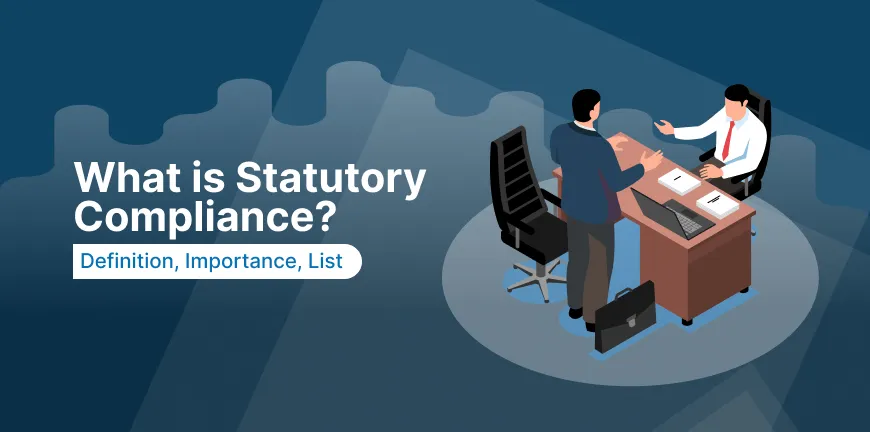
HR Leadership 2.0: Developing Workforce Resilience in Times of Economic Uncertainty
18/07/2025
What is Compliance in Business?
22/07/20251. What is the meaning of compliance?
Compliance meaning refers to a process of adhering to laws, regulations, policies, or standards applicable to business activities to prevent penalties & lawsuits, maintain ethical operations, and meet contractual or regulatory obligations. The complaint requirements vary based on location, product type, state-wise regulations, etc.
2. What is regulatory compliance?
Regulatory compliance is a systematic process that involves adhering to state and central government rules, industry regulations, and legal frameworks applicable to business operations, such as environmental laws, labour regulations, and sector-specific requirements.
3. What is statutory compliance?
Statutory compliance is a standardised process of adhering to laws explicitly mandated by legislation, such as tax payments, employee benefits, or health and safety standards imposed by local, state, or national authorities.
4. What is legal compliance?
Legal compliance is a stipulated process that requires companies to operate within the boundaries of all applicable laws, regulations, and legal agreements governing their activities, contracts, products, or services.
5. What is HR compliance?
HR compliance is a compulsory mandate that requires companies to ensure that all human resource practices follow labour laws, anti-discrimination policies, wage regulations, workplace safety requirements, and organisational policies governing employment relationships.
6. What is statutory compliance in HR?
Statutory compliance in HR refers to a specific process that requires fulfilling mandatory legal obligations related to employee wages, provident funds, ESI, gratuity, taxation, and other workforce-related statutory requirements.
7. What is compliance in a company?
Compliance in a company involves implementing processes, controls, and policies to meet legal, regulatory, and ethical standards governing all aspects of operations, finance, and employee management.
8. What is compliance in accounting?
Accounting compliance is a specific adherence process related to the accounting function in a company, which means accurately recording, reporting, and disclosing financial information in line with accepted standards, tax laws, and regulatory frameworks.
9. What is a compliance audit?
A compliance audit is a systematic review assessing whether a company adheres to regulatory requirements, internal policies, contractual obligations, and relevant industry standards.
10. What is non-compliance?
Non-compliance refers to shortcomings like failing to follow laws, regulations, or policies, potentially resulting in penalties, legal action, reputational damage, or operational disruptions for the business.
11. What are compliance risks?
Compliance risks are potential legal, financial, or reputational damages that arise when a company fails to follow applicable laws, regulations, standards, or internal policies governing its operations. The common compliance risks include regulatory non-compliance, data privacy breaches, inadequate record-keeping, unethical employee conduct, third-party compliance failures, etc.
12. What is a compliance policy?
A compliance policy is a formal document that outlines a company’s commitment to follow relevant laws, regulations, ethical practices, and internal controls, guiding employees on expected behaviours and procedures.
13. What is a compliance framework?
A compliance framework is a structured set of guidelines, processes, and controls that organisations use to ensure adherence to legal, regulatory, and internal requirements across business functions.
14. What is a compliance management system?
A compliance management system is a comprehensive structure of policies, procedures, tools, and oversight mechanisms designed to identify, manage, and prevent regulatory violations within a company effectively.
15. What is compliance management in HR?
Compliance management in HR ensures employee practices, policies, and documentation meet labour laws, tax regulations, diversity rules, and workplace safety standards to avoid legal and operational issues.
16. What is compliance management software?
Compliance management software automates monitoring, reporting, documentation, and audit trails, helping organisations track regulatory changes, manage risks, ensure policy adherence, and maintain up-to-date compliance records across departments.
17. What are the key elements of a compliance risk assessment?
The key elements of a compliance risk assessment include identifying legal obligations, evaluating existing controls, assessing risk likelihood and impact, monitoring high-risk areas, and documenting findings to guide compliance planning and risk mitigation.
18. How to implement an effective compliance program?
The steps to implement an effective compliance program include establishing a compliance officer, creating clear policies, conducting training, implementing monitoring tools, performing audits, encouraging reporting, and continuously updating the program based on regulatory changes and internal assessments.
19. What are the penalties for non-compliance with labour laws?
Penalties for non-compliance with labour laws include monetary fines, imprisonment, back wage payments, license cancellations, increased inspections, and reputational damage, depending on the severity and jurisdiction of the labour law violation.
20. What are the consequences of non-compliance for businesses?
Non-compliance in business can lead to financial losses, legal action, reputational harm, operational disruptions, employee dissatisfaction, reduced investor trust, and, in severe cases, business suspension or permanent closure.
21. How does compliance impact company reputation and trust?
A strong compliance program builds stakeholder & customer trust, boosts investor confidence, attracts talent, and protects brand reputation. Contrastingly, non-compliance damages credibility, causes legal issues, and leads to long-term reputational harm.
22. What are the latest compliance trends in 2025?
The latest compliance trends in 2025 include AI-driven compliance tools, ESG reporting mandates, real-time regulatory monitoring, cybersecurity compliance frameworks, and a shift toward proactive risk management across global operations.
23. What are the most common compliance challenges businesses face?
The most common compliance challenges businesses face these days include adapting to changing regulations, managing multi-jurisdictional requirements, employee awareness, lack of automation, data security concerns, and ensuring third-party and vendor compliance.
24. What is the difference between compliance and ethics?
Compliance is following external laws and internal rules, whereas ethics is making morally right decisions beyond legal obligations. Moreover, compliance is mandatory while ethics is about integrity and values.
25. What industries are most affected by compliance regulations?
The industries most affected by compliance mandates include finance, healthcare, pharmaceuticals, education, manufacturing, and energy. The regulatory complexities in such industries are due to strict standards on data privacy, safety, taxation, and environmental and financial reporting requirements.
26. How do you train employees on compliance requirements?
Employees must be offered interactive training sessions, role-based modules, real-life scenarios, regular updates, and assessments to reinforce understanding of policies, laws, and ethical expectations across all departments.
27. How often should compliance audits be performed?
Compliance audits should be conducted annually or biannually, with more frequent checks in high-risk industries or after significant regulatory, organisational, or operational changes.
28. What are the objectives of a compliance audit?
The objectives of a compliance audit include verifying adherence to laws, policies, and procedures, identifying gaps or risks, ensuring accountability, and recommending improvements to strengthen the overall compliance posture.
29. How is a compliance audit conducted?
The auditors review documents, processes, and systems, interview employees, assess controls, and benchmark practices against regulations to identify non-compliance and recommend corrective measures.
30. What happens if a company fails a compliance audit?
Compliance audit failure can lead to corrective action demands, fines, regulatory scrutiny, reputational damage, legal penalties, and in severe cases, business restrictions or operational suspension.
31. What documents are required for a compliance audit?
Key documents necessary for a compliance audit include internal policies, financial records, training logs, risk assessments, licenses, audit trails, incident reports, contracts, and regulatory filings to demonstrate adherence to compliance standards.
32. How do you prepare for a compliance audit?
To prepare a compliance audit, companies must review internal policies, update documentation, conduct mock audits, train staff, correct known issues, and assign responsibilities. Also, ensure data and evidence are organised and readily accessible for the audit process.
33. What is digital compliance?
Digital compliance is a systematic process that ensures an organisation’s digital activities, such as data handling, cybersecurity, online services, etc., meet regulatory, legal, and ethical standards, especially regarding privacy, consumer protection, and digital record-keeping.
34. What is compliance planning?
Compliance planning involves setting clear policies, identifying regulatory requirements, allocating responsibilities, establishing timelines, and implementing systems. This ensures ongoing adherence to relevant laws, standards, and industry best practices.
35. How can technology help with compliance management?
Technology assists compliance management by automating monitoring, reporting, risk assessments, training, and document management. This enables real-time compliance tracking, reducing human error, and ensuring timely updates to regulatory changes.
36. How do you measure compliance effectiveness?
Compliance effectiveness is measured using audits, incident reports, training completion rates, policy adherence metrics, feedback surveys, and reduction in violations or penalties over time.
37. What are the different types of compliance?
The key types of compliance include regulatory compliance, corporate compliance, data privacy compliance, financial compliance, environmental compliance, and HR/labour law compliance, each addressing specific legal and operational standards.
38. How do international regulations impact compliance for global companies?
Global companies must adapt operations to local laws, manage cross-border risks, standardise policies, and ensure consistent compliance across diverse legal environments and jurisdictions to avoid penalties.
39. What is the role of a compliance officer?
A compliance officer ensures the organisation adheres to legal and regulatory requirements, develops policies, conducts training, manages audits, investigates violations, and acts as a liaison with regulators.
40. What is compliance analytics?
Compliance analytics uses data analysis tools to monitor, predict, and improve compliance performance by identifying trends, assessing risks, detecting anomalies, and supporting proactive decision-making in regulatory environments.
41. What is third-party compliance?
Third-party compliance ensures external partners, vendors, or contractors adhere to your organisation’s legal, ethical, and regulatory standards. This helps in mitigating risks, maintaining trust & operational integrity.
42. Why is third-party compliance important?
Third-party compliance protects organisations from legal liability, reputational damage, and operational risks by ensuring that third parties meet required compliance standards, especially in data handling, labour, and anti-corruption practices.
43. What are the key steps in managing third-party compliance?
The key steps in managing third-party compliance include risk assessment, due diligence, contract clauses, compliance training, regular audits, monitoring, and documentation. This ensures third parties operate within legal and ethical frameworks consistently.
44. What are the consequences of third-party non-compliance?
The consequences of third-party non-compliance include regulatory penalties, legal action, data breaches, reputational damage, disrupted operations, and financial loss due to the actions or failures of an associated third-party entity.
45. What is vendor compliance?
Vendor compliance ensures suppliers follow agreed contractual, legal, ethical, and operational standards, including quality, safety, security, and labour practices as required by the purchasing organisation.
46. What are the common vendor compliance requirements?
The common vendor compliance requirements include adherence to quality standards, timely delivery, data protection, ethical labour practices, certifications, audit rights, safety protocols, environmental policies, and compliance with industry-specific laws.
47. What is CLRA compliance?
CLRA compliance refers to adherence to the Contract Labour (Regulation and Abolition) Act, ensuring proper registration, licensing, and welfare measures for contract workers in applicable establishments.
48. What are the main provisions of the CLRA Act?
The key provisions of the CLRA Act include registration of principal employers, licensing of contractors, welfare measures for contract workers, prohibition of contract labour in core activities, and monitoring by labour authorities.
49. What is POSH compliance?
POSH compliance ensures adherence to India’s Prevention of Sexual Harassment Act by establishing policies, Internal Committees, awareness programs, and redressal mechanisms to prevent workplace sexual harassment.
50. What are the key requirements of POSH compliance?
The key requirements of POSH compliance include forming an Internal Complaints Committee, conducting awareness training, displaying policy at the workplace, maintaining records, and filing annual reports to local authorities.
Contact Us For Business Enquiry

Hariharan Iyer
Hariharan Iyer is the Vice President – Operations at ALP Consulting, bringing over 40+ years of experience in HR outsourcing and labour law compliance. He leads end-to-end HRO operations, ensuring process efficiency, statutory compliance, and seamless service delivery for clients across industries. With a strong background in labour law governance and workforce management, Hariharan plays a key role in driving operational excellence and compliance-led HR solutions at ALP Consulting.




